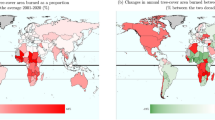Abstract
The author uses his own data gleaned from over 10 years of commercial forestry insurance across the world to propose that despite a low intrinsic fire risk across most of Southeast Asia, especially Indonesia, commercial fire losses are unacceptably high, and could be reduced substantially within the current financial legal and political framework within which forestry companies operate.
Opening with a statement about the dearth of forest fire loss data in the commercial sector, it is observed that the consequent inability of general insurers to estimate the rate of fire loss leads to very low insurance participation in forestry within Indonesia. A summary is then provided of the financial and environmental benefits of insurance participation in commercial forestry were this situation to be changed.
A short discussion on risk perceptions is introduced to make the point that without reliable commercial forest fire loss data, risk perceptions of fire exposure in Southeast Asia by the financial sector, including insurers, is a barrier to risk transfer and investment. While real fire risk and perceived fire risk for Indonesia seem at present to be in agreement, the paper challenges that this should the case.
Comparisons are made with different parts of the world with the knowledge that, in commercial terms, plantations in the low latitudes behave similarly everywhere in terms of fire causes, fire propagation factors, and characteristics of plantation or managed mixed forest fires. A review of the fire sizes within commercial forests is a good indicator of the efficiency of fire management strategies, and profiles from a high fire risk territory and Indonesia are compared.
Using commercial and unidentified data the author then demonstrates that commercial growers in Indonesia have a high annual rate of forest fire loss and may also have a significant catastrophe fire exposure. This ‘cat’ exposure is far greater than for equivalent plantations in clearly higher fire risk environments. These conclusions are and should be discussed with forestry companies to change attitude and investment levels.
Practical points for improved plantation fire management are made along with comments about the resources required. A parallel discussion then reviews fire risk assessment and management by the insurers to prevent their own ‘forest fire’ losses if they are to get further involved with the provision of Indonesian commercial forest risk transfer. The explanation of how insurers price risk within a portfolio helps identify the specific data needed for a proper risk management strategy to be developed.
Similar content being viewed by others
References
Tacconi L (2003) Fires in Indonesia: causes, costs and policy implications. Bogor, Indonesia, CIFOR. CIFOR Occasional Paper. No. 38. vi, 24p
FAO (2000) Global Forest Resource Assessment. http://www.fao.org/forestry/foris/webview/forestry2/ index.jsp?siteId=3321&langId=1
FAO (2001) State of the World's Forests. http://www.fao.org/forestry/foris/webview/forestry2/index.jsp? siteId=3321&langId=1
FAO Newsroom. http://www.fao.org/english/newsroom/news/2003/21962-en.html (June 2004)
Author information
Authors and Affiliations
Corresponding author
Rights and permissions
About this article
Cite this article
Cottle, P. Insuring Southeast Asian commercial forests: Fire risk analysis and the potential for use of data in risk pricing and reduction of forest fire risk. Mitig Adapt Strat Glob Change 12, 181–201 (2007). https://doi.org/10.1007/s11027-006-9042-9
Received:
Revised:
Accepted:
Published:
Issue Date:
DOI: https://doi.org/10.1007/s11027-006-9042-9




